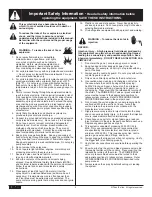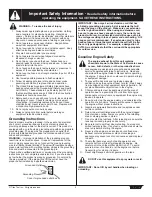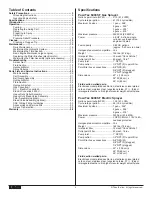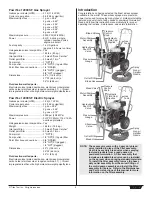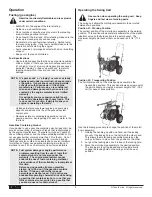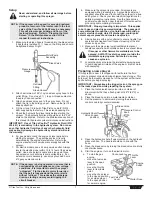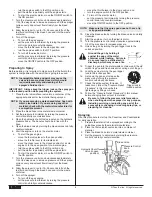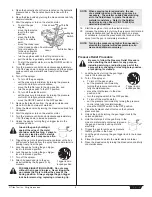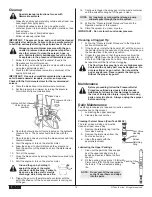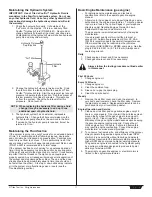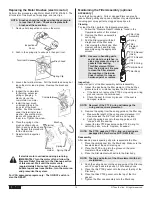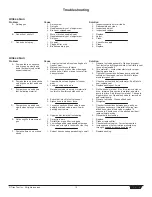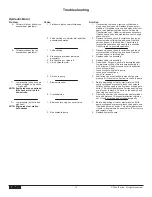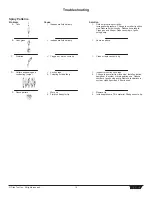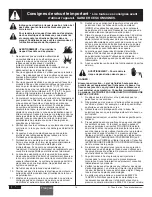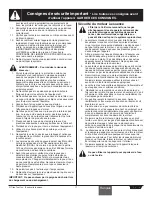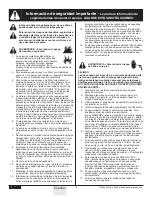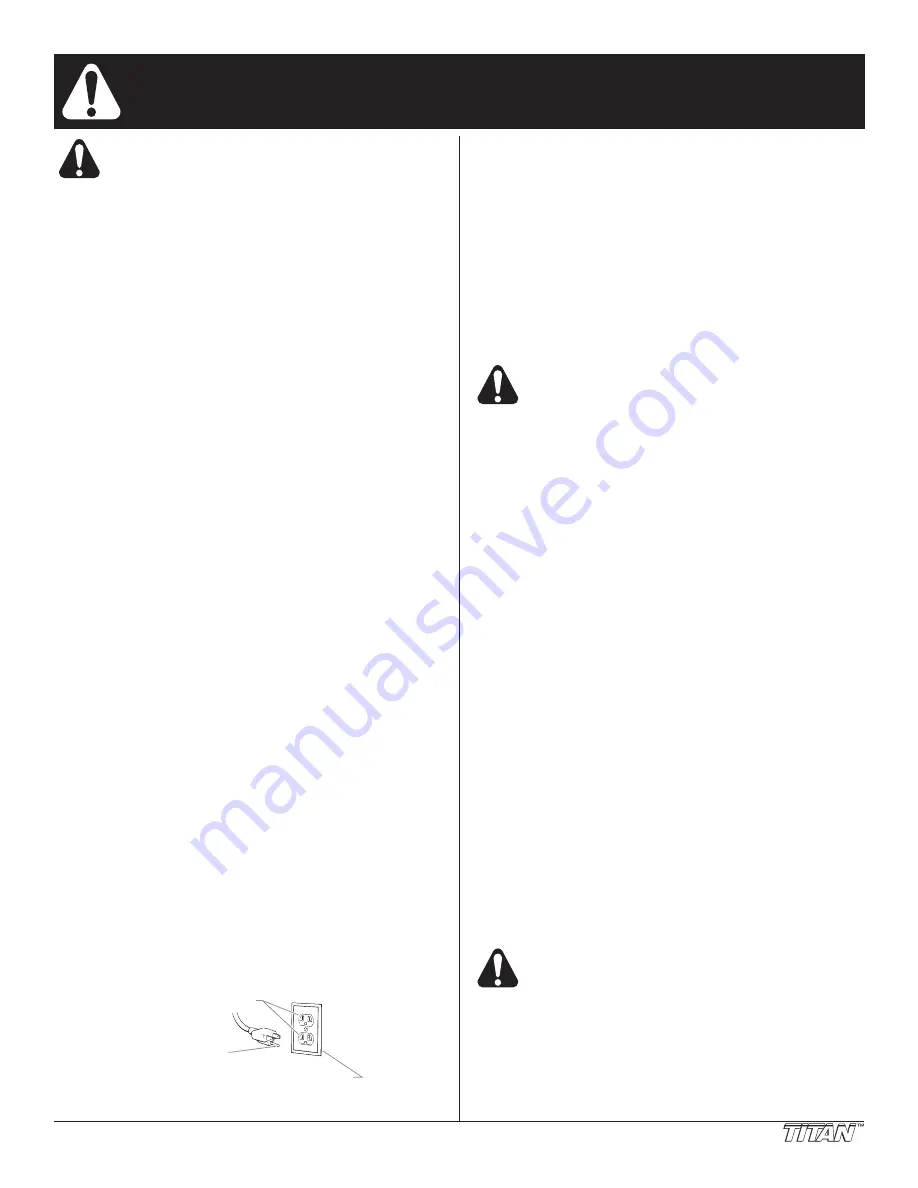
© Titan Tool Inc. All rights reserved.
3
Important Safety Information
·
Read all safety information before
operating the equipment. SavE ThESE INSTRucTIONS.
WaRNING – To reduce the risk of injury:
1. Always wear appropriate gloves, eye protection, clothing
and a respirator or mask when painting. Hazardous
vapors – Paints, solvents, insecticides, and other materials
can be harmful if inhaled or come in contact with body.
Vapors can cause severe nausea, fainting or poisoning.
2. Do not operate or spray near children. Keep children
away from equipment at all times.
3. Do not overreach or stand on an unstable support. Keep
effective footing and balance at all times.
4. Stay alert and watch what you are doing.
5. Do not operate the unit when fatigued or under the
influence of drugs or alcohol.
6. Do not kink or over-bend the hose. Airless hose can
develop leaks from wear, kinking and abuse. A leak can
inject material into the skin.
7. Do not expose the hose to temperatures or pressures in
excess of those specified by manufacturer.
8. Do not use the hose as a strength member to pull or lift the
equipment.
9. Use lowest possible pressure to flush equipment.
10. Follow all appropriate local, state and national codes
governing ventilation, fire prevention and operation.
11. The United States Government Safety Standards have
been adopted under the Occupational Safety and Health
Act (OSHA). These standards, particularly part 1910 of
the General Standards and part 1926 of the Construction
Standards should be consulted.
12. Before each use, check all hoses for cuts, leaks, abrasion
or bulging of cover. Check for damage or movement
of couplings. Immediately replace hose if any of those
conditions exist. Never repair a paint hose. Replace with
a conductive high-pressure hose.
13. Do not spray outdoors on windy days.
14. Always unplug cord from outlet before working on
equipment (electric models only).
Grounding Instructions
Electric models must be grounded. In the event of an electrical
short circuit, grounding reduces the risk of electric shock by
providing an escape wire for the electric current. This product is
equipped with a cord having a grounding wire with an appropriate
grounding plug. The plug must be plugged into an outlet that
is properly installed and grounded in accordance with all local
codes and ordinances.
WaRNING — Improper installation of the grounding plug can
result in a risk of electric shock. If repair or replacement of the
cord or plug is necessary, do not connect the green grounding
wire to either flat blade terminal. The wire with insulation having a
green outer surface with or without yellow stripes is the grounding
wire and must be connected to the grounding pin.
Check with a qualified electrician or serviceman if the grounding
instructions are not completely understood, or if you are in doubt
as to whether the product is properly grounded. Do not modify
the plug provided. If the plug will not fit the outlet, have the
proper outlet installed by a qualified electrician.
Grounded Outlet
Grounding Pin
Cover for grounded outlet box
IMPORTaNT: use only a 3-wire extension cord that has
a 3-blade grounding plug and a 3-slot receptacle that will
accept the plug on the product. Make sure your extension
cord is in good condition. When using an extension cord,
be sure to use one heavy enough to carry the current your
product will draw. an undersized cord will cause a drop in
line voltage resulting in loss of power and overheating. a 12
gauge cord is recommended. If an extension cord is to be
used outdoors, it must be marked with the suffix W-a after
the cord type designation. For example, a designation of
SJTW-a would indicate that the cord would be appropriate
for outdoor use.
Gasoline Engine Safety
The engine exhaust from this unit contains
chemicals known to the State of california to cause
cancer, birth defects, or other reproductive harm.
1. Gas engines are designed to give safe and dependable
service if operated according to instructions. Read and
understand the engine Owner’s Manual before operating
the engine. Failure to do so could result in personal injury
or equipment damage.
2. To prevent fire hazards and to provide adequate
ventilation, keep the engine at least 1 meter (3 feet) away
from buildings and other equipment during operation. Do
not place flammable objects close to the engine.
3. Children and pets must be kept away from the area of
operation due to a possibility of burns from hot engine
components or injury from any equipment the engine may
be used to operate.
4. Know how to stop the engine quickly, and understand the
operation of all controls. Never permit anyone to operate
the engine without proper instructions.
5. Gasoline is extremely flammable and is explosive under
certain conditions.
6. Refuel in a well-ventilated area with the engine stopped.
Do not smoke or allow flames or sparks in the refueling
area or where gasoline is stored.
7. Do not overfill the fuel tank. After refueling, make sure the
tank cap is closed properly and securely.
8. Be careful not to spill fuel when refueling. Fuel vapor or
spilled fuel may ignite. If any fuel is spilled, make sure the
area is dry before starting the engine.
9. Never run the engine in an enclosed or confined area.
Exhaust contains poisonous carbon monoxide gas;
exposure may cause loss of consciousness and may lead
to death.
10. The muffler becomes very hot during operation and
remains hot for a while after stopping the engine. Be
careful not to touch the muffler while it is hot. To avoid
severe burns or fire hazards, let the engine cool before
transporting it or storing it indoors.
11. Never ship/transport unit with gasoline in the tank.
DO NOT use this equipment to spray water or acid.
IMPORTaNT: Do not lift by cart handle when loading or
unloading.
Содержание SPEEFLO PowrTex 12000 SV
Страница 35: ...Titan Tool Inc All rights reserved 35 Notes...


